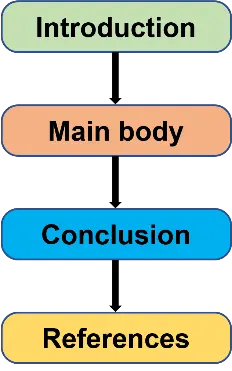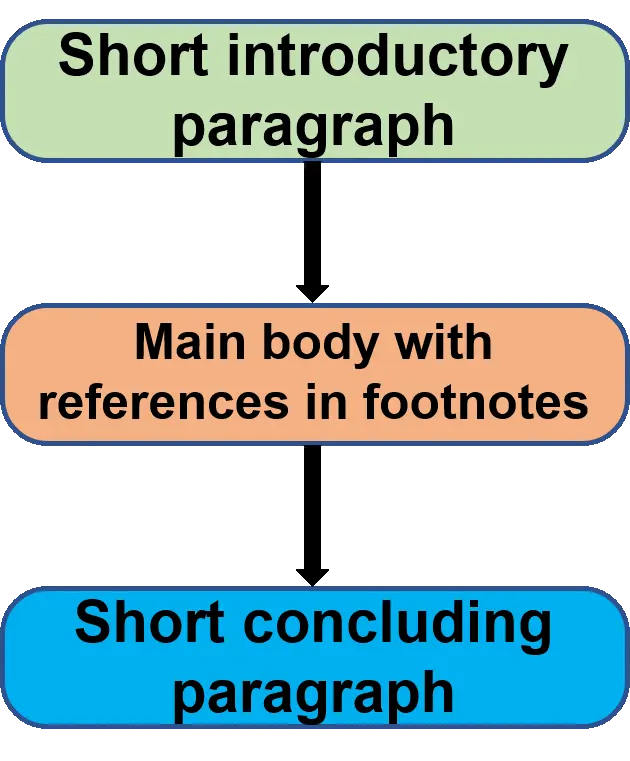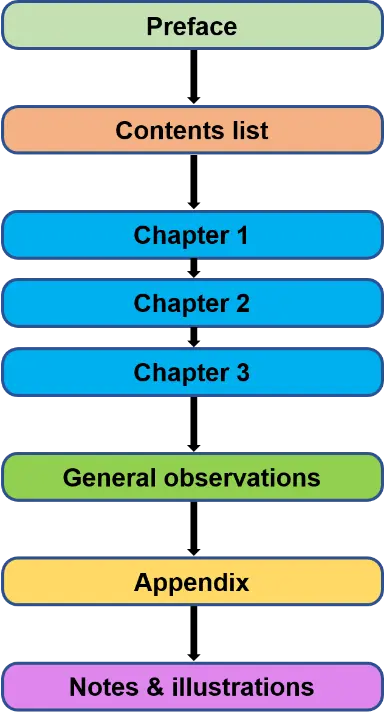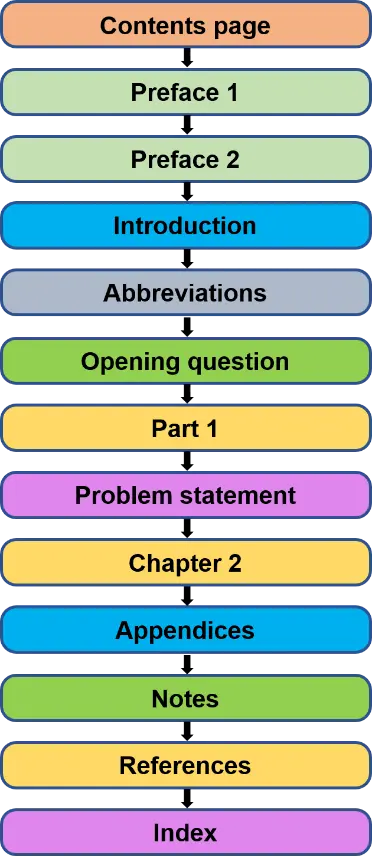If you have come to this article knowing little about disquisitions, we have produced a disquisition guide that introduces them. But if you already know what a disquisition is, or have read that article, this guide will help increase your knowledge specifically on how to structure one, should you choose or be asked to write one.
When it comes to composing sentences and paragraphs, it is good to know that a disquisition does not require any special construction in this regard. This guide will focus on structure in terms of arranging the main components of academic works.
What is Structure?
The structure of academic work refers to the type of information included, and its arrangement; different papers have different requirements. The most detailed paper is the dissertation, with numerous sections within other sections. Theses have fewer parts, and a simple essay has fewer still.
The structure of academic work follows logical principles. In brief, they begin by introducing the topic, and if applicable, a specific problem connected to it, often referred to as the thesis statement. The writer tells the reader: I am going to discuss a specific problem or address a question within this subject area. This introduces the reader to the work early on.
Next comes what is called the body; this contains the bulk of the information or the argument. After the body, the author summarises everything in a conclusion, referring to the original problem or question. In a short essay, this may be all that is required – not forgetting the reference list.

Much longer texts that delve more deeply into subjects, especially technical subjects, require extra information in the form of appendices, technical terms require glossaries, tables & diagrams, which then require lists of tables & diagrams. As an academic work grows, it usually requires more components.
Why do Works Have so Many Possible Different Sections?
It is important to remember the two main reasons for producing academic work: First, it is a test for writers to prove themselves and showcase their knowledge of a subject, or to achieve a particular qualification as part of a course of study.
The other reason is to create something that adds value to the existing material on the subject. Writers intend their work to be read, so agreed-on rules for organizing material within scholarly papers helps their readers. It especially helps those who regularly read them.
Frequent readers of dissertations know they can find certain types of data in specific sections. Dissertations, theses, and essays conform to such standards, but the disquisition does not have such rules. This can be considered as negative or positive depending on the viewpoint.
Disquisitions allow the writer a certain amount of freedom in assembling the work, but the organization the writer chooses might not fit the expectations of those who regularly consume academic works. So, how should you put a disquisition together?
Do Disquisitions have Officially Recognized Structures?
The answer to this is both yes and no, or – it depends. What does it depend on? It depends on whether you have been asked to or have decided to write a disquisition and to label it as such: Disquisition on the health impact of a vegan diet. If you have been instructed to “write an academic piece” investigating a subject deeply, you may have unwittingly been asked to write a disquisition.
If you have been asked to write a disquisition in the form of a dissertation, then follow the structuring guidance for a dissertation, and similarly for theses or other kinds of paper. You can find a clearer breakdown of the differences and similarities between dissertations, theses, and disquisitions in this guide.
If writing “a disquisition” and intending to label the work as such, it offers the writer some leeway.
By examining disquisitions from the past until recent times, it is clear that there are more options of what can be included as opposed to what has to be included. If there is no officially recognized disquisition structure, we can investigate disquisitions to see what structures the authors used.
Examples of Structure
Many disquisitions were written in the form of books. In Alexander Blackrie’s book, A Disquisition on Medicines that Dissolve the Stone (1766, 123 pages), he refers to his work as a treatise, which is another term for a deep investigation into a subject. This is an older work and does not contain headings throughout.
He begins by describing a health problem he suffered (kidney stones), which prompted his investigation into all possible remedies for it. Although not titled as such, we can take this as an introduction.
The work covers various remedies, and how to make and prescribe them. Each is described in turn, and then Blackrie ends with a short concluding paragraph. There is no references section, instead, all references appear as footnotes on the pages where they are cited.

William Robertson’s The Disquisition Concerning Ancient India, (1791, 296 pages) begins with a preface, then a contents list, describing three body sections, then a fourth which contains general observations, the appendix, and notes and illustrations.
Use of the word preface is more common in books than academic papers. If the disquisition is to be a published book, maybe the introduction can be renamed as the preface?

A more recent work – Johannes Heckel’s Lex Charitatis, (1973, 680 pages) – begins with a contents page, preface, an excerpt from the preface from a previous edition, the introduction, and abbreviations. This is followed by an opening question based on the book’s topic, then there is part 1, a problem statement, chapter 2, appendices, notes, references, and finally an index.

Over time, it appears the structure has evolved and become more detailed. But this could just be the writers’ preferences. In the second example (Robertson) there is no section titled Introduction, nor is there an index. This does not mean it is wrong, or that they are missing, the author chose not to include them.
What Purposes do the Different Components Serve?
There are as many sections as necessary, all serving to assist writers and readers of texts in their own ways. A disquisition’s purpose is to convey information to the reader; nobody wants to fight their way through the text to find what they want.
Think of the finished work as a store of information – a box of facts. Unlike a novel, the work might be read by the same reader multiple times, but not the whole thing. If the information within is useful for other researchers or interested parties, they might want to locate specific information only. Organizing work into sections makes this task easier.
If certain types of information are usually contained in certain sections, readers can go directly to those parts. Well-organized academic papers allow readers to access and retrieve certain data more easily.
Consider a long disquisition with everything contained in the main body: all abbreviations and technical terms being defined when they first appear in the text, and data tables appearing when mentioned.
Reading the whole thing could still be informative and interesting, but locating and extracting specific information would quickly become complicated and tedious. This could make an inferior but better organized work more preferable to work with just because it is more accessible.
Why Your Disquisition Should be Structured for Convenience
Be aware that these days people have shorter attention spans; the internet and electronic documents make information instantly available. Disquisition writers – indeed any writers – of the past did not have to contend with this phenomenon, but writers today do.
Some of the satisfaction of reading academic work derives from content, and some from the user-friendly way the material is assembled.
The disquisition, then, seems to offer this freedom of choice. To some extent, the subject determines the length of the work. The subject’s complexity, technical level, and the length of the paper mostly determine which sections will be required.
Are There Sections that Should, Shouldn’t, Have to, or Don’t Have to be Included?
Let us consider a ten-page exploration into the different types of tissues available, for example. At this length, it probably should not have an index, contents page, or a critical assessment of the literature, or at least, it will not require them. Including extra components to something short could appear to be dressing it up: bad practice on a par with using unnecessarily long, showy words.
Superfluous sections in a short paper could dilute or even hide its message. A ten-page paper padded out to twenty-five pages with unnecessary sections will only make it feel insubstantial.
Only include parts that improve the overall work somehow. Unnecessary pages are clutter. If considering extra sections when there is no definite need for them, apply the rule: if in doubt, leave it out.
Add only if you need to, not because you want to. Adding extra sections is justifiable in longer works, especially those covering more technical subjects.
We will assume you are reading this because you intend to write something substantial. The disquisition is a deep investigation into a subject, and likely to be a reasonable length. Thus, the work will undoubtedly comprise several components.
So, What Sections Will You Need to Include?
As stated earlier, length and level of technicality mostly dictate the required sections. The advice here is to familiarise yourself with the sections frequently used in academic works. Choosing which sections to include comes about by necessity and the intention to better present the work.
Do not invent new sections or put sections in unusual places: a contents list goes at the front, an index at the back. Predictability is a positive here; give readers what they expect. Here is a list of components commonly used in academic works.
| Component | Contents |
| Title page | Project title, author, document type, submission date, names of academic dept., university, supervisors, and intended degree |
| Acknowledgements | Thanks to those who helped |
| Abstract | Summary of work’s content – its basic outline |
| Table of contents | List of contents from this point onwards |
| List of figures and tables | Descriptions of figures & tables, their page numbers |
| List of abbreviations | Definitions of abbreviations used within |
| Glossary | Alphabetical list of definitions of specialist/technical terms |
| Introduction | Topic definition, previous studies, aims & objectives |
| Literature review | Summary of sources used, analysis of their content |
| Methods/methodology | The research question, design method & rationale for it, evaluation of method, and its limitations |
| Results or findings/analysis | Unbiased presentation of results |
| Discussion | Explore relevance & significance of findings |
| Conclusion | Concise review of research & findings |
| References/bibliography | List of sources quoted & referred to |
| Appendices | Tables, illustrations, and figures that add more background |
What is the Correct Order?
The table above shows the sections in what is generally considered as a correct order. Yes ‘a’ correct order: researching ‘the’ correct order of components brings several variations. This mostly concerns the front section and where to place acknowledgements, the table of contents, and the abstract. Many institutions have in-house rules on these. If your university has a prescribed order, then follow that.
Otherwise, create an outline first – this will give some idea of the required components. If your work only requires 5 or 6 from the table above, use them but do not change the order. It is wise to stick with convention on this aspect.
How do I Find a Good Subject to Write About?
If you are free to choose your subject, there are plenty of different methods to help find the right one. Some require the help of other people, and some methods can be done by the individual. It is an important area because the topic is the seed from which the whole piece of work grows.
As such, these methods are not part of this guide. We have provided a more detailed guide focussing on creating the right topic.
How Long is a Disquisition?
Our response to this question is to ask if you have been instructed to write a disquisition, or if you have chosen to write one. If you have been asked to write one, then whoever requires it of you should also provide a word or page limit.
A thesis might have 100 pages, and a dissertation up to 300. But it is not possible to apply a number so readily to a disquisition; range in length varies greatly. Although, if the definition of a disquisition is an academic text that investigates a subject deeply, one would expect it to be more than just a few pages long, unless of course, it looks into a very specific question with a small scope.
There is no upper length limit for a disquisition, and a couple of factors affect its length: the scope of the subject you are looking into, and how deeply you look into it. There is also a limiting factor concerning how deeply one can look into a subject – a quite obscure subject might have little material available to investigate.
Do I Need to Include a Reference Section or a Bibliography?
Regardless what you write about, referring to and quoting others’ work means you have to cite where you found it and who it is accredited to. So, yes, a reference section is required because it is extremely unlikely you can research anything and not find something worth repeating. You will also need to use in-text citations as in any other work.
Disquisitions do not require any specific referencing style. As with any essay or formal work, the referencing style is either down to the university, or personal choice.
What Does all This Mean?
How you assemble your disquisition is your choice. Of course, you are free to invent your own components and rules, and to organize them in ways never seen before. But where would that get you? Would anyone take you seriously?
When you write anything, you do it for your readers, not your own amusement. This is why there are conventions to follow. While the rules on disquisitions do not firmly state that you have to do certain things, the rules on academic writing do; and they are not about to change. Therefore, we suggest sticking to them and upholding these longstanding practices.
There is a sense of safety for readers when work is presented in a predictable order; it allows your reader to be comfortable when they take the time to read your work. Do not try to impress your readers through startling unorthodox presentation styles, do it by giving them good, quality material structured in a way that makes the reading pleasurable.
Frequently Asked Questions (FAQs)
1What is a disquisition?
A disquisition is a formal and detailed examination or discussion of a particular subject. It involves a systematic and scholarly exploration of a topic, often presented in writing, to provide in-depth analysis, explanation, or argumentation.
2What is the structure of a disquisition?
A disquisition typically follows a structured format with an introduction, thesis statement, body paragraphs presenting arguments or analysis, and a conclusion. It adheres to a logical flow, providing evidence and supporting details to substantiate the central idea or argument.
3Is disquisition the same as dissertation?
No, a disquisition and a dissertation are similar but not identical. Both involve an in-depth exploration of a subject, but a dissertation is a formal academic document required for a degree, while a disquisition is a broader term referring to any detailed discussion or examination of a topic.